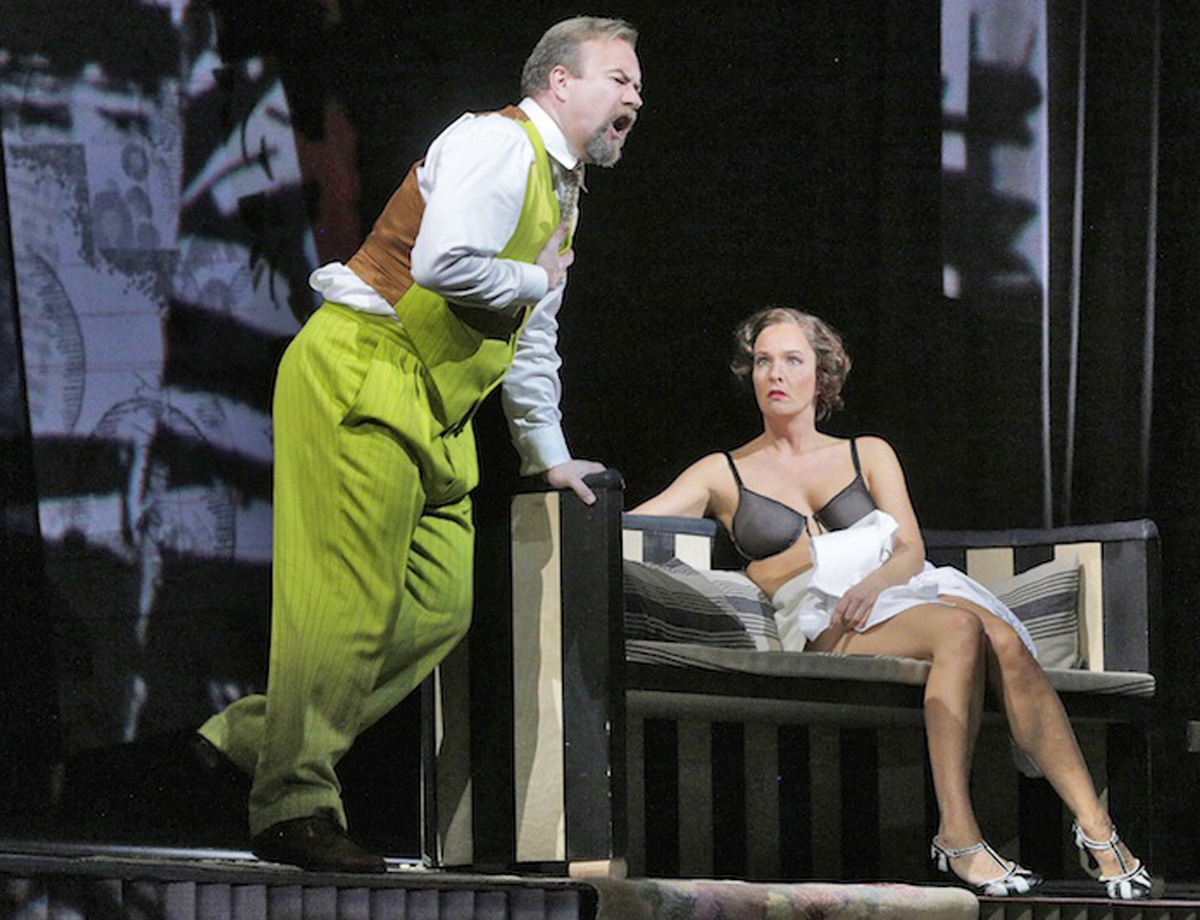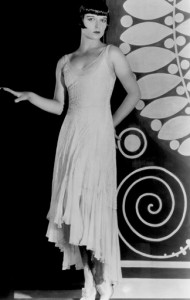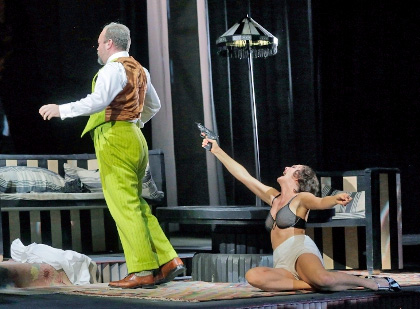
Alban Berg’s only two operas, Wozzeck and Lulu are filled with depravity, bloodshed and sex. Audiences and critics have denounced them as sordid and pornographic. Therefore you might assume he led a dissolute and degenerate life—especially since Berg picked his subjects and wrote his own librettos as well as the music.
To the contrary, the composer was an intellectual and patrician man. The conductor Sylvan Levin worked with Berg preparing the singers and orchestra for the first American production of Wozzeck (in Philadelphia in 1931). He also socialized with Berg and his wife and he told me that the composer spoke perfect English, was sophisticated and charming. There were no scandals nor violence. He did not hang out with criminals nor prostitutes as the characters in Lulu do.
That assessment is confirmed by Karen Monson and by Willi Reich in their definitive biographies of Berg.
The personality of Berg became pertinent when this production of Lulu displayed images of him as a prominent part of the show. His face is projected all over the scenery, almost as voluminously as images of Lulu; thus we are prompted to examine what kind of man he was. The South African visual artist William Kentridge set this production in Berg’s time (the 1920s) and used Wiemar-era German art. This might lead the viewer to believe the opera is Berg’s biography, but that certainly was not the case.
Rather, Berg was intellectually intrigued by the writings of Frank Wedekind (the author of Spring Awakening, Earth Spirit and Pandora’s Box) and set Wedekind’s Lulu stories to music, utilizing some traditions of old composers, like canzonetta, cavatina and waltz, mixed with the new atonality of his mentor, Arnold Schoenberg.
Berg’s music is intentionally disorienting. Instead of using one or two tones as main points of focus, like key centers in tonal music, he used twelve tones with no one predominating. He assigned each of his main characters a row of twelve notes, each to be given equal importance before returning to start the row again. To complicate things, the row can be transposed, or played backward or upside down. Berg’s music has such unusual relationships and ingenuity that listeners accustomed to simpler music might balk. It’s brainy music, much of it subtle, revealing its beauty only with repeated hearings.
Lulu is the story of an amoral young woman who leads a series of admirers to destruction and death before she is in turn killed by Jack the Ripper. The drama, like the music, is more intellectual than lurid. We observe the tragedies in Lulu’s life without developing empathy for her, nor for her avaricious suitors and hangers-on. When Lulu has her throat cut in the final scene, we don’t feel grief. Rather, we feel that the drama has reached an inevitable and satisfying conclusion. Lulu herself never showed grief or regret as her lovers died.
A contrast exists between Berg’s two operas, Wozzeck and Lulu. The title character Wozzeck is abused by his bosses, his doctor and his wife until he’s driven to an act of violence, so we grieve for him. Lulu, on the other hand, is an object of voyeurism but does not earn our sympathy. Berg’s intentional objectivity creates a chilling, gripping effect.
Berg’s music does include emotion, as it expresses despair over a lost way of life (a reflection of the feelings of Austrians after the end of their Hapsburg Empire in 1918.) His score evokes the decay of the European aristocracy and its successors, the leaders of business and financial institutions.
The music also has moments of humor. A last-act scene of stock market speculators losing their life’s savings is observed comically, as is a dramatic moment in Act II. Lulu has shot and killed her husband Schön. Now she’s about to have sex with his son Alwa but pauses to observe, “Isn’t this the sofa where your father bled to death?” And Alwa calmly responds, “That doesn’t affect me.”
In Acts I and II, Lulu lives high; in Act III she descends to work as a whore. This dramatic progression, and the jagged music that accompanies it, was handled with intensity and considerable beauty by the German soprano Marlis Petersen.
Schön (the Danish bass-baritone Johan Reuter) found Lulu on the streets as a teenager and exploited her before later becoming her third husband. Alwa (American tenor Daniel Brenna) is a composer who is dependent on her even when she cheats on him. A Painter (tenor Paul Groves) tries to capture Lulu on canvas in a series of portraits and sexually-explicit sketches.
Mezzo Susan Graham was superb as the lesbian Geschwitz who also yearns for Lulu’s attention. Martin Winkler was impressive as the Animal Trainer who opens the opera, and also as the Acrobat who recruits Lulu to prostitution. An old man (Franz Grundheber), who may be Lulu’s father, drifts into many scenes.
The last act has some of the male characters return in different guises (played by the same men) as customers of Lulu. The last of these is Schön, reincarnated as Jack the Ripper.
Kentridge filled the stage with scraps of newspapers, paper hats, Rorschach blobs of ink, and those sexually explicit sketches. The newsprint and the paper goods probably were allusions to tabloid journalism, the profession of Schön. The India ink appears to be a metaphor for blood. We also see a mannequin-like figure at a piano, who turns out to be a real person; a servant who slouches across stage pushing the scenery; and a look-a-like of Lulu who mimes her actions, like a mirror image.
All this was fascinating but a bit excessive; so much was going on at one time. I wanted to concentrate more on the characters and the orchestra, which was powerful at key moments and lyrical at other times. German maestro Lothar Koenigs did a marvelous job of interpreting this complex score.
This problem should be obviated when Lulu is seen in HD at movie theaters around the world. With closeups on the characters, the busy background activity will be less obtrusive.
By the way, its interesting to note that Berg wrote Lulu at the same time that George Gershwin was working on Porgy and Bess and Shostakovich was composing Lady Macbeth from Mtsensk; three unusual operas, three disparate styles.
See video clips, courtesy of Metropolitan Opera:


Above, Louise Brooks, the movie Lulu; and Petersen shoots Reuter in the opera
See other reviews on The Cultural Critic